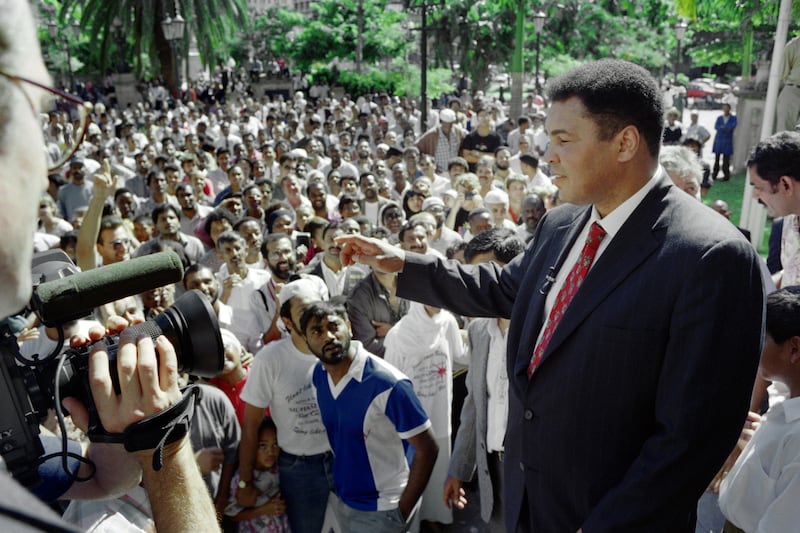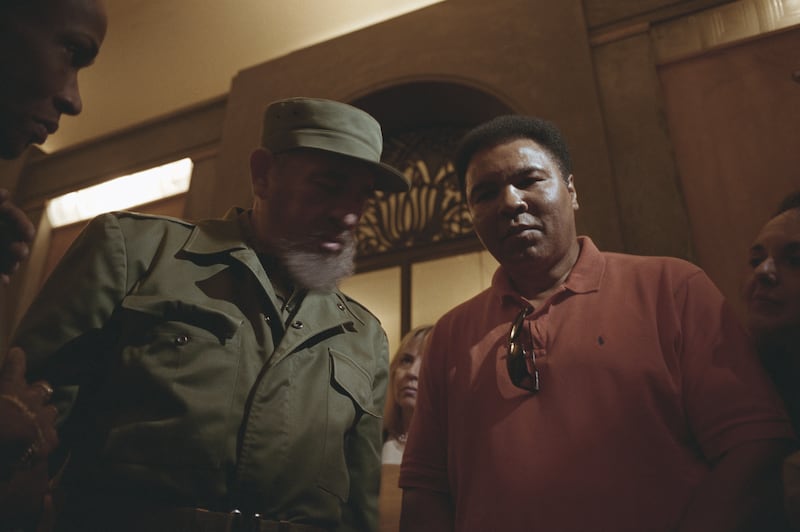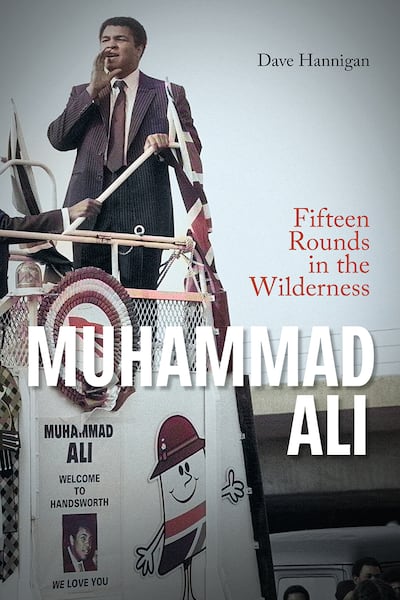After Nelson Mandela spoke at Los Angeles City Hall on June 29th, 1990, there was a star-studded event at the Museum of Sciences and Industry, attended by, among others, Jane Fonda, Lionel Richie, Harry Belafonte, Sidney Poitier, and Kris Kristofferson.
By that point, on the last leg of an exhausting eight-city jaunt across the United States, tour co-ordinator Roger Wilkins bristled at the celebrity clamour to get close to Mandela, warning that a man recently released after 27 years in prison was not “a movable photo opportunity”. Yet, the leader of the ANC remained a fan at heart too.
“We were walking together and, all of a sudden, I saw his face light up as I’d never seen it light up before,” said Wilkins. “He looked past me with a radiant smile. I felt his entire body straighten up and, almost reverentially, he whispered to me, ‘Champ’. And, of course, walking towards us was Muhammad Ali.”
*
Protestant churches face a day of reckoning with North’s inquiry into mother and baby homes
Pat Leahy: Smart people still insist the truth of a patent absurdity – that Gerry Adams was never in the IRA
The top 25 women’s sporting moments of the year: 25-6 revealed with Mona McSharry, Rachael Blackmore and relay team featuring
Former Tory minister Steve Baker: ‘Ireland has been treated badly by the UK. It’s f**king shaming’
On April 10th, 1993, Chris Hani, the general-secretary of the South Africa Communist Party, was assassinated as he got out of his car at his home in Dawn Park with his 15-year-old daughter Nomakhwezi. Shot four times by Janusz Walus, a Polish immigrant and far-right extremist, he died at the scene. His death sparked intense rioting, prompted a one-day national strike and near enough plunged South Africa into civil war. On that very date Muhammad Ali happened to touch down for a long-planned visit.
“The following two weeks, the time Ali spent in South Africa, proved to be the most tumultuous, taut and politically nerve-racking in the three years since president F W de Klerk decided to open the floodgates and initiate talks with the ANC (African National Congress),” wrote John Carlin. “Somehow, all went well. If anything, Ali’s trip was the richer. He saw the anger and the tragedy of black South Africa, as well as the exuberance.”
At the Elgangeni Hotel in Durban one evening, Ali asked the personal assistant to the manager to type up a letter to Nelson Mandela, taking into account the traumatic events of the previous few days.
“Dear Mr. Mandela,
Allow me to extend to you and the ANC my deepest regrets upon hearing of the death of Chris Hani. My prayers go out to Mr. Hani’s family and the people of South Africa during these difficult days.
I am providing you the following information regarding my itinerary should you desire to contact me (prior to our scheduled meeting on 19 April, 1993)….
Inshallah, I pray that God keeps you safe.”
Yours Sincerely,
Muhammad Ali.”
The man typing the letter was so nervous about the task given the import of the communication that he initially misspelt Muhammad with an “e”. It was only after it had been signed by Ali that somebody noticed the mistake and requested a new, amended version be produced.
Fareed Hoosen, a 20-year-old working for a VIP security firm, was part of the detail travelling with Ali throughout the country. On the first day they met, Hoosen confessed to the man he was supposed to protect, “When I was a kid, I watched all your videos”.
Ali smiled, tapped him on the back and said, “I’m just a regular guy”.
And, in this case, very much a wide-eyed tourist too.
“He loved going to the Bo-Kaap, the mosques, to Gugulethu,” Hoosen said. “Once, standing at the Waterfront, he looked at the top of Table Mountain and said: ‘It’s very interesting that it’s a flat mountain. But how did they build the cable car house at the top? Did they first build the cable car, then take up the bricks?’ We laughed, but then we thought about it.”
As the country came to terms with the violent aftermath of the killing, Ali turned up for a protest march in Cape Town on April 14th, alongside the likes of Bishop Desmond Tutu. After the march ended, a group of young men on the rampage surrounded the bus carrying Ali and appeared bent on doing damage. At least until they realised who it was carrying. Then, they raised their clenched fists and chanted, “Ali! Ali! Ali!”

No matter which city he was in, Hoosen and the security team were instructed again and again to stop the convoy in poor neighbourhoods so Ali could get out and meet the people.
In Soweto Township in Johannesburg, he visited a mosque, an orphanage and the famous Dube boxing club. There he excused himself from sitting with dignitaries to go outside, to where a gaggle of kids were sparring on the grass. Mandal Mahlalela was the smallest of the boys and he was the one Ali chose to engage, squaring up to the diminutive pugilist and warning, “I’m gonna get you, Joe Frazier!”
Mbongeni Ngema and Laura Jones had co-written a musical called Magic at 4am, the story of a South African goldminer and enthusiastic amateur boxer who based his entire life and personality on Ali. The man himself turned up for the premiere, sitting in the mayor of Johannesburg’s box, and, at the end, he went onstage to dance and spar with the lead actor. Moves that brought the house down.
There was serious business to be attended to as well. Ali visited Hani’s widow Limpho, met the former minister Tokyo Sexwale and, despite concerns that it might degenerate into violence, he insisted on attending the funeral at a football stadium in Soweto. There, he spent time consoling Hani’s kids and issued a statement, calling for those hurt by the assassination to keep pursuing their goals through politics rather than violence.
“The call of democracy is too important,” he said, “and your future too precious to allow the act of a single man to interfere with your destiny.”
Amid all this chaos and tumult, there came the summit with Mandela himself. The men had met for the first time in Los Angeles three years earlier, and the leader of the ANC had made it known in interviews that Ali was one of his heroes (on Robben Island, he used to copy the boxer’s poses when he saw them in magazines), and an inspiration to millions of black South Africans during the decades of the struggle against apartheid. Now that he was finally in his home country, Mandela poured him tea and the two men enjoyed a respite from the conflict whirling around them.
“When I met Ali for the first time, I was extremely apprehensive,” said Mandela. “I wanted to say so many things to him. He was an inspiration to me even in prison because I thought of his courage and commitment to his sport. He used mind and body in unison and achieved success. I was overwhelmed by his gentleness and his expressive eyes. He seemed to understand what I could not say and, actually, we conversed very little. When he came to South Africa, I was proud of how the hero of millions of young people was received here. Ali is my hero and will remain the master of boxing to me.”
Mandela kept a photograph of the boxer in his office for the rest of his life.
*
Shortly after 9pm on January 22nd, 1996, having kept his audience waiting for nearly an hour, Fidel Castro swept into a reception room at the Palace of the Revolution in Havana, wearing combat fatigues and sporting the most famous straggly grey beard in the world.
“Buenas noches!” said the 70-year-old to the assembled crowd. “Buenas noches!”
Then he walked directly towards Muhammad Ali and embraced him.
“I am glad to see you,” said Castro through an interpreter. “I am very glad to see you and I am thankful for your visit.”
The Cuban leader stared into his eyes, but Ali didn’t respond, even as the cameras flashed to capture the moment.

He had arrived in Havana four days earlier as part of a charitable mission delivering $500,000 in medical supplies to the Cuban people.
Among his travelling party was his wife Lonnie, his best friend Howard Bingham, a CBS 60 Minutes television crew led by Ed Bradley, and the famed American magazine writer and author, Gay Talese. Also by his side for much of the week-long trip was Teofilo Stevenson.
Three-time Olympic champion from Cuba, Stevenson is regarded as the greatest amateur heavyweight of all time. Throughout the 1970s, there had been serious and persistent talk about him meeting Ali in the ring if he chose to accept any of several lucrative offers to turn professional. He didn’t (or couldn’t) so the fight never happened.
But, having visited Ali in Michigan the previous year, the 6ft 5in superannuated boxer became the official chaperone for Ali’s visit. And the man who filled in the gaps when this verbally-challenged version of Ali, instead of speaking to Castro, playfully raised his right fist towards the chin of the leader.
Stevenson spun a yarn about how the two fighters had put on an exhibition a couple of days earlier in the storied Balado gym, watched by the new generation of Cuban contenders. Perhaps for the benefit of his leader’s ego, he made the encounter sound more like the contest the sporting world had once wished for between the pair.
“Stevenson did not actually explain that it had been merely another photo opportunity,” wrote Talese, “one in which they sparred openhanded in the ring, wearing their street clothes and barely touching each other’s bodies and faces . . .”
Earlier in the visit, there had been a press conference where the two would-be heavyweight rivals posed for photographs and one reporter asked Ali how the fight between him and Stevenson might have gone. With a smile on his face, he whispered his answer to his wife on the dais, and she said, “It would have been a tie”.
The perfect diplomat’s response. And Ali was playing that part perfectly. He had visited Havana’s Neurological Institute, a destination for Parkinson’s sufferers from around the world, delivering a shipment of Carbidopa/Levodopa drugs for the patients. He did not, as some had rumoured, seek any treatment there himself.
“We are here on a humanitarian mission,” said Lonnie Ali. “We’re hoping we can do something to relieve some suffering. Muhammad has always been willing to transgress political boundaries to do what is important. Muhammad has always been an ambassador to the world. He’s not a political animal.”
For the meeting with Castro, the Ali camp had come bearing gifts. Bingham handed over an enlarged, framed version of one of his photographs, in which the 21-year-old fighter still known as Cassius Clay is walking along a sidewalk in Harlem with Malcom X. “TO PRESIDENT FIDEL CASTRO, FROM MUHAMMAD ALI,” read the inscription under which Ali had also added a little heart. Castro lifted it up closer to his eyes, surveyed the work and announced, “Que bien!” before showing it to his interpreter.
At one point in the encounter, Bradley got a microphone in front of Castro and began asking serious questions. That interaction was cut short by Ali starting to do magic tricks to entertain the crowd, a distraction that caught Fidel’s eye. If those who travelled with Ali had seen him make a handkerchief disappear a thousand times before, the first secretary of the central committee of the Communist Party of Cuba appeared taken aback by such a wondrous feat.
“Where is it?” cried Castro, who approached Ali and started to examine his hands. “Where is it? Where have you put it?”
Castro was so impressed by what he had just witnessed that Ali, through an interpreter, had to painstakingly explain it to him, outlining the crucial role played in the ruse by a fake rubber thumb. Even then, he insisted on attempting it himself so Bingham, who as Ali’s oldest friend had perhaps witnessed this particular trick more times than any man alive, gave him a brief lesson. Castro then made the handkerchief disappear, the crowd duly applauded, and Ali insisted he could keep the rubber thumb as a memento.
(Dave Hannigan’s Muhammad Ali: Fifteen Rounds in the Wilderness is published by Pitch Publishing and available on June 20th)

Between defeat by Trevor Berbick in December 1981 and lighting the Olympic flame in Atlanta in July 1996, Muhammad Ali spent the 15 most turbulent years of his life traversing the globe, seeking a higher purpose. Depending on the day, the retired champion could be a diplomat trying to liberate hostages in the Middle East, a salesman flogging cookies and cologne across America, or an amateur magician performing sleights of hand everywhere from prison yards to school halls to Valentino fashion shows.
Sometimes hilarious, often terribly poignant, this kaleidoscopic account of the most bizarre episodes in his epic life chronicles Ali preaching Islam, causing havoc and touching lives from Beijing to Birmingham, Detroit to Damascus, Khartoum to the Khyber Pass. One minute hanging with Donald Trump, the next with Nelson Mandela, even as his own body and mind battled the onset of Parkinson’s Syndrome, here are so many previously untold stories about ‘The Greatest’ treating statesmen and strangers, popes and paupers just the same.






